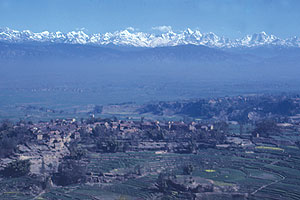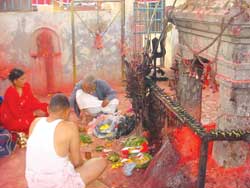 It is hard to keep up with a half-man, half-woman protector, destroyer, and a manifestation of the energy that rules the world. Given that there are 108 important Shiva shrines (and probably half-a-million secondary ones), it's no surprise that people often miss out on one of the most interesting of them, right here in the Valley.
It is hard to keep up with a half-man, half-woman protector, destroyer, and a manifestation of the energy that rules the world. Given that there are 108 important Shiva shrines (and probably half-a-million secondary ones), it's no surprise that people often miss out on one of the most interesting of them, right here in the Valley.
It might be the bumpy half-hour ride, followed by the steep 15-minute climb that deters people from visiting the Santaneswor Mahadev, which is second in importance only to Pashupatinath, the official protector of the nation. But those who make the effort to get to the tiny red-drenched temple in Jharuwarasi, near Thaiba Lalitpur come away feeling peaceful and truly blessed. Of course, you have to watch the thoughts that cross your mind when you're there, because Santaneswor is the deity that watches over people who cannot have children.
So if you aren't ready yet for a small, squalling, prune-faced human in your life, go strictly as a tourist. On a clear day, this is Nepal at its best. Why go trekking, when from this vantage point you can one moment look up to views of mountains from the Annapurna to the Jugal, and the next, direct your gaze down to the little villages and terraces dotting this idyllic part of the Valley. And perhaps this is another reason couples anxious about their future without children find that coming here gives them some measure of solace.
For as long back as the oldest Valley residents can remember, this pilgrimage has been made by people from near and far, usually twice. Until a few years ago, a major draw was the Santaneswor Baba, whose blessings were sometimes rumoured to take rather carnal forms. People came regardless, and they continue to do so, even though he isn't around anymore to act as the go-between between them and the good lord. "I have seen hundreds of couples coming and asking for a child in my lifetime. They always come back with their six month child for the paasni, the rice-feeding ceremony, because it is important that they thank Santaneswor," says 67-year-old Shiva Shrestha, the bhajan master of the temple, who, after he recorded his devotional songs, now spends his entire day in the temple.
The stories explaining how the temple came into being are as numerous as the names of Shiva himself. Hindu holy texts such as the Swasthani talk of how Shiva was carrying the body of his dear, dead wife Sati around the world, when parts of her started to fall on different places. Just as Guhyeswori in Kathmandu and Kamakhya in Assam, India, are said to be formed from rather more intimate parts of Sati, Santaneswor Mahadev is the temple that arose when her upper lip fell to the ground here.
Others talk of how Kamadhenu, the cow that fulfils all wishes, made Jharuwarasi and Godavari her regular haunts to dispense free milk-after all, the supreme lord can only bathe in pure milk. The eternal milk source is represented here by a small stream of water below the boulder in the sanctum sanctorum. Locals swear the cow is responsible for this little rivulet that never dries up
 Santaneswor sits atop a hillock flanked by two similar, smaller hills and the entire area is the stuff of legends, temples and pilgrimage. The name of the place, Jharuwarasi, for instance, comes from the story of the Jhara people who once lived here. No one knows where they went, or if the present-day locals are their descendants. Some disagree with this version, saying that the mighty Pandava Bhimsen, followed by his army, was chasing the evil Kitchak. Given Bhimsen's enormous appetite and incredible strength, his \'army' was more an army of porters carrying food, some of which they lost along the way. The grain they spilt here gave rise to the three hillocks. There are many stories about the numerous temples near by, from the Naudhara, the shrine of the goddess Pulchowki in Godavari, to Bajrabarahi in Chapagaun to the west, and Nawadurga in Thecho. But this homage to the God of Unborn Children is more charming than most, for the stories and the vistas it offers.
Santaneswor sits atop a hillock flanked by two similar, smaller hills and the entire area is the stuff of legends, temples and pilgrimage. The name of the place, Jharuwarasi, for instance, comes from the story of the Jhara people who once lived here. No one knows where they went, or if the present-day locals are their descendants. Some disagree with this version, saying that the mighty Pandava Bhimsen, followed by his army, was chasing the evil Kitchak. Given Bhimsen's enormous appetite and incredible strength, his \'army' was more an army of porters carrying food, some of which they lost along the way. The grain they spilt here gave rise to the three hillocks. There are many stories about the numerous temples near by, from the Naudhara, the shrine of the goddess Pulchowki in Godavari, to Bajrabarahi in Chapagaun to the west, and Nawadurga in Thecho. But this homage to the God of Unborn Children is more charming than most, for the stories and the vistas it offers.
Sure, it is hard to get to, but the pure and pious locals are doing all they can to make the pilgrimage easier. They recently organised a yagya, a sacred fire ceremony, and raised Rs 1.6 million for temple development, which sounds a little scary, but there is nothing to fear-no luridly painted sub-shrines or souvenir stalls playing tinny music and selling religious kitsch. A good deal of the money was spent on building the gravel road that leads to the base of the temple, some to establish a trust and the rest to build a community hall in the temple complex. And Krishna Bahadur KC, a teacher at Kitini Higher Secondary School and long-time patron and philanthropist loyal to the temple, hopes this will serve as an example to other religious monuments. "We can account for every rupee donated to the temple. We hope this will be an example to the entire nation," he says. There's more to be done. The community is trying to raise money to build steps leading to the temple, as the steep trail can be dangerous when it rains. If this wonderfully benign manifestation of Shiva appeals to you, you can donate Rs 650 to build one step, and have your name engraved on it in the deal.


